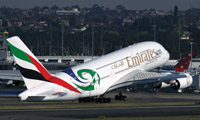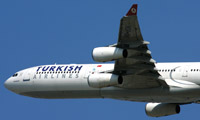Main Story
TARGETTED: THE ASIA-PACIFIC
European, the U.S. and Middle Eastern airlines are increasing their focus on the world’s fastest growing travel market. Recently evidence has emerged that reveals the impact non-regional carriers are having in the Asia-Pacific.
June 1st 2013
It is no secret that airlines from Europe, North America and the Middle East have their sights set on increasing their presence in the Asia-Pacific as air traffic continues its upwards course. Read More »
| At a glance: * Seven out of the world’s top 10 busiest routes are in the Asia-Pacific. * By next year, the Asia-Pacific will account for 30% of all passengers, followed by North America at 23%. * Of the 800 million new passengers to fly by next year, 360 million of them will be from the Asia-Pacific. * China alone will account for 214 million new passengers. * Last year, passenger growth in the Asia-Pacific was 9%, nearly double the world average and well ahead of second placed Latin America with 6%. |
Now, a new analysis by IT major, Amadeus, has thrown the spotlight on just how much impact the expansion of Gulf airports and their carriers is having on long-haul traffic flows to and from the region.
It says 15% of all passenger traffic between the Asia-Pacific and Europe is travelling through the three Gulf hubs of Dubai, Doha and Abu Dhabi. And, says the report, it is likely to get worse. While overall traffic volume between the region and Europe is growing at 7% annually, traffic routed through the Middle East last year increased 20%.
The analysis, from Amadeus’ Air Traffic Travel Intelligence Solution, says the Middle East is becoming an increasingly important global air travel hub. If that isn’t bringing enough pressure to bear, it also shows Asia-Pacific airlines face a tougher competitive landscape than anywhere else in the world.
According to Amadeus, 75% of the region’s air routes are fought over by three or more airlines and 27% by five or more airlines, “making this a region with very intense competition in all its air travel routes”.
This contrasts sharply with other regions such as the Middle East and Europe where just half of all air routes are operated by three or more airlines. It says the highly competitive nature of air travel in Asia may be due to the high concentration of passengers on a relatively low number of “super routes”, where several airlines vie for dominance.
Pascal Clement, head of travel intelligence at Amadeus, said the rapid pace of change and increasing competitiveness of the global airline industry means airlines and the travel industry in general increasingly need to base operational decision-making on data insights and analytics, in order to identify opportunities and risks as they emerge.
But he said the data provides some good news for the wider industry, showing that passenger air traffic “has increased in every region of the world from 2011 to 2012. As in 2011, this growth is led by Asia. However, the data points to a further opportunity in the region, where the majority of traffic is on a small number of busy routes”.
 |
| Emirates Airline: planning to increase capacity on its Bangkok and Hong Kong services later this year |
Competition or not, the report says the world’s busiest air routes by passenger volume are now dominated by Asian domestic travel, with seven out of the top 10 world’s busiest routes in the region.
Jeju-Seoul in South Korea remains the world’s busiest air route. Beijing-Shanghai has risen from seventh busiest in 2011, to fourth in 2012. Sapporo-Tokyo has overtaken Rio de Janeiro-Sao Paulo to become second busiest. Okinawa-Tokyo has entered the top 10, as the ninth busiest route in the world.
“This concentration of Asian air travel suggests the region’s growth may continue as there is an opportunity for airlines to develop secondary links beyond the heavily competitive super routes,” says the analysis.
Significantly, it shows that in Asia, the larger routes with over 100,000 annual passengers have a 4%-9% growth range, but the smaller and medium-sized routes are growing at approximately 19%-21% per annum, presenting big opportunities for airlines to expand their networks.
International carriers from outside the region are scrambling to gain a bigger foothold in any way they can.
Steffen Harbarth, Lufthansa German Airlines Singapore-based vice-president for the Asia-Pacific said: “We are not the only carrier to see how huge the growth rates are and where passengers are willing to travel to … so we are focusing on this region and we intend to continue doing so in the years ahead.
 |
| 'We are talking about the biggest and most dynamic aviation market in the world with double digit rises in passenger numbers in some areas' |
| Steffen Harbarth Vice-President, Asia-Pacific Lufthansa German Airlines |
“We can talk about Hong Kong, Mumbai, Seoul, and Shanghai, Beijing, Chengdu and other booming cities in China, more or less showing the same picture of growth and dynamic commerce.
“We are talking about the biggest and most dynamic aviation market in the world with double digit rises in passenger numbers in some areas.”
Finnair chief operating officer, Ville Iho, said his carrier is aiming to double the revenues it collects from its Europe-Asia traffic by 2020, largely by throwing some of its 11 A350 XWBs into the battle after deliveries begin in 2015.
This month, Finnair is launching two routes to Asia, Xi’an, China and Hanoi, Vietnam. The carrier will become the first European airline to connect directly to the cities and increase its Asian destinations to 13. “North Asia-North Europe is the sweet spot for Finnair,” said Iho.
Turkish Airlines chief executive, Temel Kotil, wants to add five destinations in China and is waiting for approval from Chinese authorities. It currently serves Beijing, Shanghai and Guangzhou.
On a rapid growth path, Turkish recently ordered 15 A330s and 15 B777s. It is building Istanbul as a major hub between Europe and Asia. The centre of gravity for air traffic has been steadily shifting from West to East in the past three decades, said Kotil.
Last month alone, several non-Asian operators launched routes into the region. American Airlines began daily non-stop services from its base at Dallas/Fort Worth to Incheon in Seoul, South Korea, reinforcing American’s commitment to expand and strengthen its global presence, especially in the Asia-Pacific region, according to Chuck Schubert, American’s vice-president for network planning.
Turkish Airlines added Kuala Lumpur to its Southeast Asian network in addition to Bangkok and Ho Chi Minh City. Air France returned to Kuala Lumpur in May after an absence of 20 years and Lufthansa-owned SWISS is flying again to Singapore after an absence of four years.
Also, airlines are beginning to serve more secondary destinations. For example, in April KLM Royal Dutch Airlines launched a direct service between Fukuoka, Japan, and Amsterdam, the first carrier to connect the city directly with Europe. And this month, Hawaiian Airlines will launch a new service to Sendai, returning to Honolulu via Sapporo, giving the carrier its fifth destination in Japan.
It is not only Asia-Pacific to Europe routes that are being attacked. Abu Dhabi-based Etihad Airways recently launched a service to Washington that links with its flights to Bangkok, offering Asian passengers an alternative route to the U.S.
 |
| Turkish Airlines: waiting for approval for five more destinations in China. It currently serves Beijing, Shanghai and Guangzhou |
Most flights to the U.S. east coast from Asia fly across the Pacific in the opposite direction. Etihad can now offer one-stop services through its home hub to Washington, Chicago, New York and Toronto. It is pushing the service with special discount fares.
Last month, Dubai-based Emirates Airline announced it was planning to increase capacity on its Bangkok and Hong Kong services later this year. In Hong Kong it will go from three to four flights daily. It will increase capacity by upgrading from A330-200s to B777-300ERs.
This is only the tip of the iceberg. While air traffic growth in the northern hemisphere has slowed considerably in the face of tough economic conditions, the Asia-Pacific is booming. Last year, passenger growth in the region was 9%, nearly double the world average and well ahead of second placed Latin America with 6%.
These levels are expected to continue for years to come. And while additional capacity from outside the region is adding to competitive pressures, local airlines are also continuing to add seats.
Indeed, seat capacity in the Asia-Pacific has increased 80% in the past decade, according to aviation data and analysis group OAG. It said this can largely be attributed to the expansion of capacity in Indonesia’s domestic market and an increase in services between mainland China and Taiwan.
Its latest report, in February, revealed airlines in the regional market added 4.8 million seats during the month compared with the same period last year, taking seat capacity to just under 100 million, a 5% year-on-year increase. Southeast and Northeast Asia are highlighted as key growth drivers, increasing seat capacity by 12% and 5% respectively.
The International Air Transport Association (IATA) estimates that by next year, the Asia-Pacific will account for 30% of all passengers, followed by North America at 23%.
Of the 800 million new passengers who will fly by then, 360 million of them, or almost half, will be in the region. China alone will account for 214 million passengers.
Asia is now the unchallenged leader in aviation, with 787 million air journeys last year. If the present rate of increase continues, the one billion passenger figure will be overtaken in 2015.
Even worsening airport congestion is failing to stop airlines increasing capacity. They are seeking more landing slots and local partners who will help feed their expanding fleets with increasing numbers of Asian passengers.
Lufthansa’s Harbarth said getting additional traffic rights wasn’t the main problem. “It is getting slots at the airport, particularly when you need these slots at a certain time to fit in with your structure,” he said.
“From Europe most of the airports have curfews. That means if you are flying out of the Asia-Pacific you have to request slots to fly out not earlier than 2200 hours otherwise you will arrive early in Europe.
“It’s not only an issue in the northeastern part of the Asia-Pacific. In Taiwan, Tokyo, Korea and China, it’s exactly the same.”
The answer, according to Harbarth, is twofold. “It’s not causing a brake for us. Our expansion in the Asia-Pacific is, on the one hand, going for new destinations which are not slot restricted and, secondly, to bring in larger aircraft,” he said.
“We used to fly to Tokyo daily with the B747-400. We brought in the A380 and that’s a capacity increase of 120 seats and the cost per seat is lower.”
Air France, which started its Paris - Kuala Lumpur service with B777s, is talking about replacing them with A380s. “There is big potential for us here. We are targeting Malaysian tourists and businessmen to use our aircraft. We are optimistic considering we also have daily flights to Bangkok and Singapore,” said Air France chairman and chief executive, Alexandre de Juniac.
“Nowadays the ASEAN area with Malaysia, Indonesia, Thailand and Singapore represent a major opportunity for businesses, so we need to cover more … we are here for the margins and traffic.”
Said Harbarth: “[The Asia-Pacific is] a booming market with high growth rate. At the same time there is very tough competition pricing wise and quality wise.”
But he is confident the prospects are bright. “Germany has 82 million inhabitants and average travel behaviour of 2.5 flights per person per year. The average in China is still 0.44. It has 1.4 billion inhabitants. Just imagine what will happen in the years to come when maybe the average will be one per year, 1.5 or 2,” said Harbarth.
Despite the lull in the freight market foreign carriers are active in expanding cargo networks in the region. Turkish Airlines cargo volume through Hong Kong has increased nine times to 1,800 tonnes per month since 2008.
Next year, it plans to resume freighter services to Shanghai and start a new service to Chengdu. It is also looking to adding Southeast Asian destinations such as manufacturing hubs in Vietnam and Thailand. Emirates SkyCargo this month increases its cargo capacity to Tokyo’s Haneda airport.